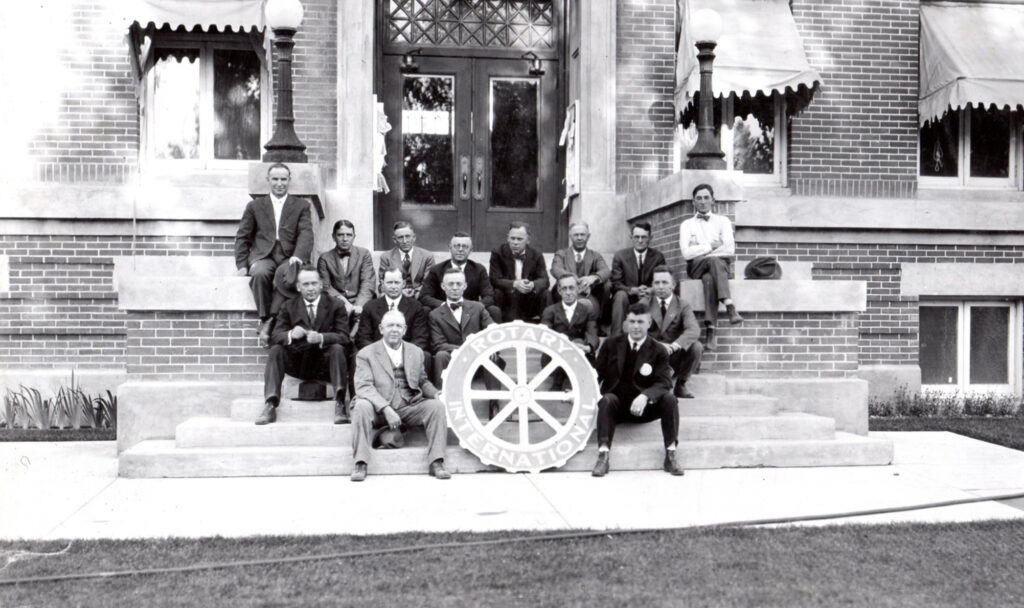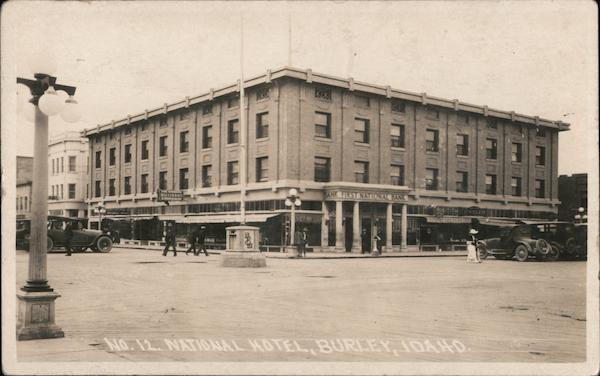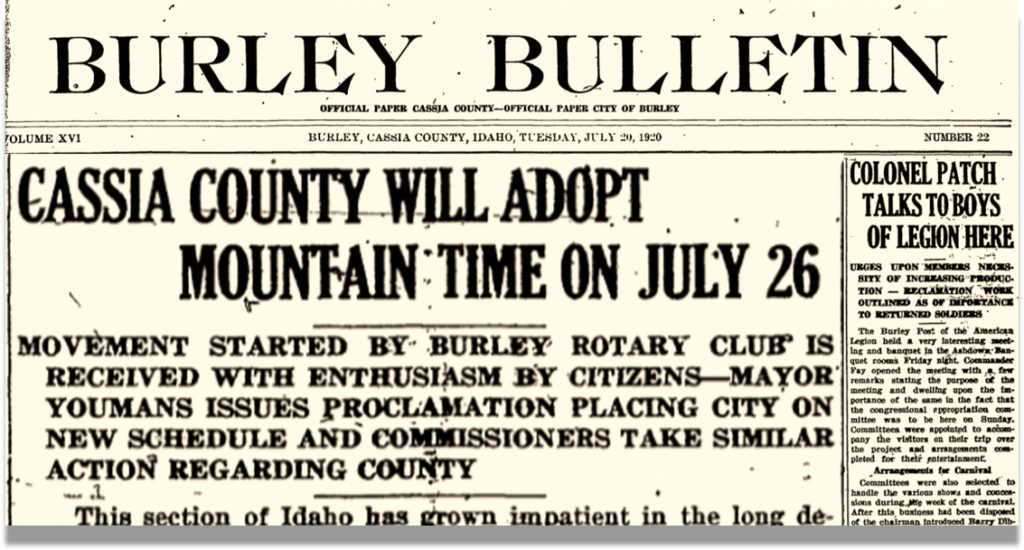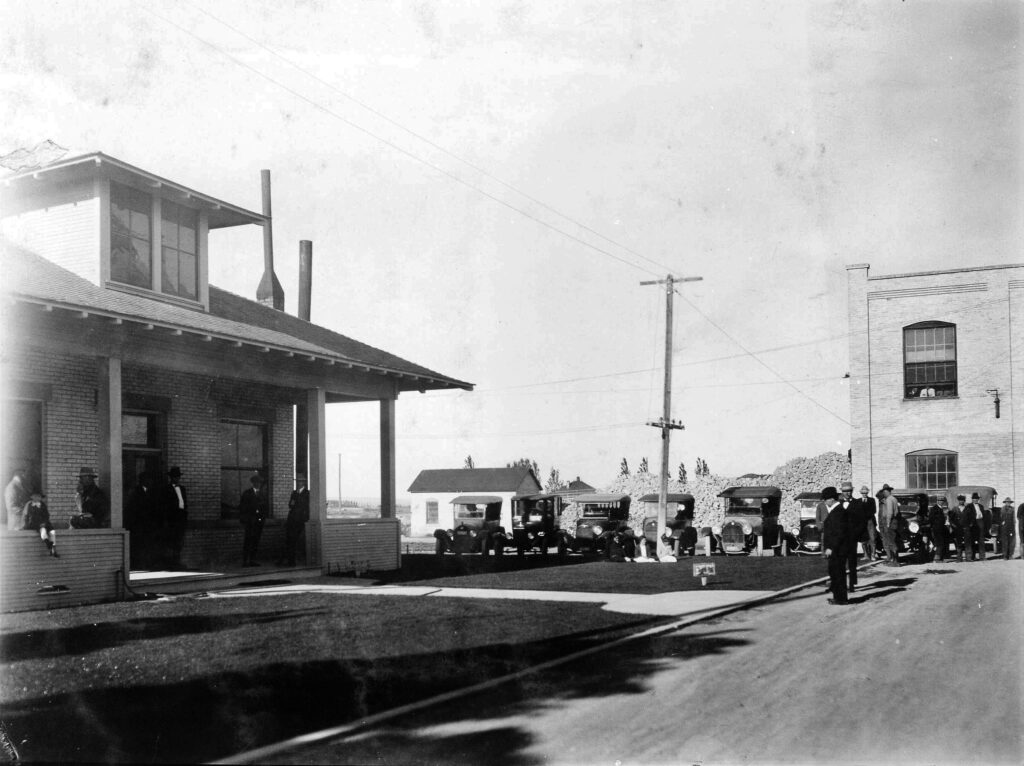About BURLEY ROTARY
Burley Rotary Club Formed and Organized
On October 28th 1919, eighteen community members met at the bluebird Café along with Ralph E. Lewis of the 20th district. Lewis was a representative of Rotary District Governor Joe T. Young. These men met with the intention to form a Rotary Branch affiliated with the “International Association of Rotary Clubs.”
It was at that Tuesday lunch meeting that the Burley Rotary Club was formed and organized.
Officers were elected, committees were formed, and membership to each committee was assigned. Dues were decided to be set at $20/ year with a $10 initiation fee. The club would meet each Tuesday at 12:15pm. Lunch would be paid for by each member and there would be no tolerance for tardiness. Fines were set at $0.25 for tardiness or unexcused abscesses.
7 Weeks later (December 16th, 1919) at the National Hotel dining room in Burley, a banquet was held. The National Hotel stood on the Corner of Overland and Main where Zions Bank stands today. District Governor Joe Young delivered the charter following a “sumptuous banquet and splendid music at the National Hotel.” (Burley Bulletin). Some twenty Rotarians accompanied Governor Young from Pocatello by “special train” to assist in presenting the charter and initiating the Burley club.
In presenting the charter to the Burley Rotarians, Governor Young spoke very complimentary of the growth and development of the city and of the progressive spirit of its citizens who have placed Burley in the front rank in every regard. He declared that Burley, so far as he is informed, is the smallest city in the world to have a Rotary Club, and he attributed its good fortune to the spirit of progress shown on every hand.
With 19 original charter members, the club had fewer than the number required to become a Rotary Club. It took an appeal from our club leaders to receive the charter. In fact Burley was only the 4th town in Idaho to have a Rotary club.
VASE STORY: “Following the presentation of the charter, President C.C. Baker of the local Rotarians made a neat address in which he presented Governor Young with a ‘very valuable’ vase, but just as the vase was being delivered, President Baker dropped it to the floor and it broke into a thousand pieces. The look of distress on [poor] Governor Youngs face and the profound silence on the part of the other members was immediately overcome, however, when a half dozen news boys rushed into the banquet hall with an “Extra” edition of the Burley Bulletin which told the whole story of the “Terrible Accident.” This cleaver feature of the program was the product of the mind of Lloyd Solomon and it was declared a rousing success, and was highly complimented by all.“ (Everybody I would add, but Governor Young).
Leaders in the Community
And thus the Burley Rotary Club was officially chartered and formed. That original group of pioneers were anything but a lunch bunch. They were the movers and shakers of the community. They were service focused and resolved in solving the pressing concerns of the day.
Some of their first actions focused on the youth and the needy in the community. A Christmas tree and motion picture show were set up for the needy children around Christmas time. Gifts of fruit, nuts, and candy were donated and handed out. Periodic meetings where held where the Rotary Members would bring along their sons (or as the newspapers noted, would borrow one if need be) to help them learn about their civic duties and associate with these influential men of the community.
At one of their early Tuesday meetings, a Charity Fund was started to raise money to help provide for the poor and the needy in Burley. Their committees began working with local leaders to determine best approaches to meet the needs of the community. They were an influential group that knew how to get things done.
Individuals of Action
An example of the club’s resolve was on display in July of 1920. When the US government assumed control of the railroads during World War I for transportation purposes, the dividing line between Pacific and Mountain time zones was moved from Pendleton Oregon to Pocatello…leaving southern Idaho in the Pacific time zone. After the war, the shortage of daylight caused many problems for the communities in Southern Idaho where daylight, fuel, and electricity were all scarce resources. The loss of production was on the mind of the whole community.
Growing impatient in the long delay of the ICC (Interstate Commerce Commission) at putting our community back into Mountain time zone, the Burley Rotary club took up the matter in their weekly meeting and invited the public to attend. After a brief debate, all in attendance were in favor of immediate action. A motion was made to “change back to Mountain time as soon as the Burley Bulletin can spread the News.” It was unanimously adopted.
And a few days later, the Mayor of Burley put out a Proclamation ordering all clocks to be advanced one hour to Mountain Time. It helped that the Mayor Youmans was a charter member of the Burley Rotary Club.
On matters of importance, the Burley Rotary Club was looked at as trusted source for FAIR and TRUTHFUL recommendations, and subsequent action.
Fairness to all Concerned
One of the Rotary ideals focusses on “Fairness for all Concerned.” It is part of the Four Way Test of things we “think, say, or do.” In 1920, a prolonged dispute between Amalgamated Sugar Company and the Beet Growers on the Minidoka Project came to an impasse; neither side seemed willing to make further concessions which looked to threaten an entire season of beet farming.
Once again, it was the Burley Rotary that stepped in and appointed a committee to meet with officers of the Farm Bureau and a committee of beet growers. They listened to all side of the matter and then formulated a set of definite demands upon the sugar company regarding the beet contract for that year, and a statement of policy for the future. A policy that would be “Fair to all Concerned”
The demands were presented and an amicable agreement was made: Staving off what may have been a catastrophe for the local economy.




